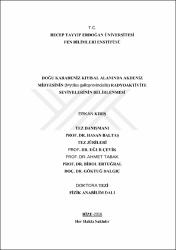DOĞU KARADENİZ KIYISAL ALANINDA AKDENİZ MİDYESİNİN (Mytilus galloprovincialis) RADYOAKTİVİTE SEVİYELERİNİN BELİRLENMESİ
Abstract
Natural (226Ra, 232Th and 40K) and artificial (137Cs) radioactivity levels were measured using germanium (HPGe) detector in soft tissue of Mediterranean mussels (Mytilus galloprovincialis) in three different sizes, sea water and sediment samples gathered seasonally from 12 stations along the coast of Giresun, Trabzon, Rize and Artvin provinces in Eastern Black Sea Region. Activity concentrations in sea water, sediment and soft tissue of Mediterranean mussel samples were observed to vary in the range 1,07?8,21 mBq L-1, 5,89?23,13 Bq kg-1, 0,69?14,37 Bq kg-1 for 226Ra, 1,56?6,71 mBq L-1, 6,32?25,29 Bq kg-1, 1,05?14,39 Bq kg-1 for 232Th, 102,66?559,40 mBq L-1, 163,84?546,92 Bq kg-1, 197,87?535,05 Bq kg-1 for 40K, 0,49?2,68 mBq L-1, 1,40?54,35 Bq kg-1, 0,16?7,71 Bq kg-1 for 137Cs, respectively. In addition, absorbed gamma dose rate (D), radium equivalent activity (Raeq), external hazard index (Hex) and annual effective dose (AED) values for sea water, sediment and soft tissue of Mediterranean mussel samples were calculated. Moreover, daily intake (Dint) of radionuclides, the annual taken effective dose (Deff) and carcinogenic risk (CR) parameters were calculated depending on the Mediterranean mussel consumption by people from the resulting radioactive concentrations in soft tissue of Mediterranean mussel. Carcinogenic risk (KRs) values from the activity results obtained in sediment samples were determined. Although there were statistically differences (p<0.05) among mussel sizes according to 232Th and 137Cs activity concentrations in soft tissue of Mediterranean mussel samples, it wasn’t observed difference according to 226Ra and 40K activity concentrations (p>0.05). The activity concentration results of radionuclides and calculated radiological risk parameters were compared with the international limit values and other studies in the literature. Although the measured radioactivity values was observed in the world average limit for natural radionuclides in all samples, the partial effect of 137Cs radionuclide reaching with radioactive cloud to our region after the Chernobyl radioactive is still ongoing. Furthermore, according to calculations, the average activity concentrations haven’t shown any risk in terms of public health.
Collections
- Fen Bilimleri Enstitüsü [340]


















